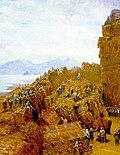Top Qs
Timeline
Chat
Perspective
Lögberg
UNESCO World Heritage Site, of the Icelandic parliament before the 14th century From Wikipedia, the free encyclopedia
Remove ads
Lögberg (Icelandic pronunciation: [ˈlœɣˌpɛrk], Old Norse lǫgberg, Old Norse pronunciation: [ˈlɒɣˌberɣ]), or Law Rock, was a rocky outcrop in south west Iceland, at the location for the assembly of the country's Althing parliament. The original Althing was gathered at Þingvellir,[1] an area of dramatic landscapes which was easily accessible from the populated areas of the south west.[2]
The exact location of the Lögberg is unknown, because of the changing geography of the rift valley over 1000 years.[3] Two possible locations have been identified in Þingvellir, one a flat ledge at the top of a slope named Hallurinn (currently marked by a flagpole), the other in the Almannagjá fault against a rock wall.[1] A site in the Hestagjá ravine has been put forward as ideal.[2]
The Lögberg was the place on which the Lawspeaker (Icelandic lögsögumaður [ˈlœɣˌsœːɣʏˌmaːðʏr̥], Old Norse: lǫgsǫgumaðr [lɒɣsɒɣʊmaðr̩]) took his seat as the presiding official of the assembly of the Althing. Speeches and announcements were made from the spot.[3] Anyone attending could make their argument from the Lögberg. The gatherings were also convened and dissolved from it.[1]
The Lögberg performed its purpose from the formation of the parliament in 930. It ceased to be used in 1262, when Iceland took allegiance to Norway.[1]
Remove ads
Gallery
- 19th-century rendering of the Law Rock in Þingvellir
- The site of the Law Rock in modern Þingvellir
- Alþingi Lögberg aerial panorama, taken in June 2017
- Detail view (2016)
References
Wikiwand - on
Seamless Wikipedia browsing. On steroids.
Remove ads



